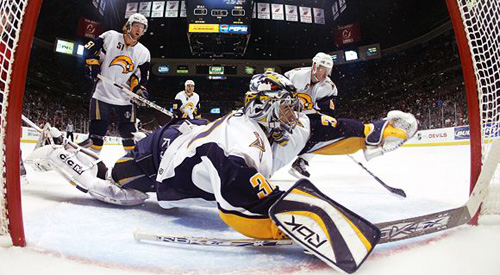
From east to west: The NHL’s Northeast Division
Although three of its five teams advanced to the postseason in 2010-11, in terms of star talent and team success heading forward, the Northeast Division is far from elite.
Whereas other divisions, like the Southeast, are anchored by the likes of Alex Ovechkin and Steven Stamkos, the Northeast consists of four mediocre teams that only generate excitement because they play in hockey-laden markets.
However, there are a number of interesting storylines to keep a tab on as the season approaches.
A contributing factor towards raising expectations in the division revolves around the Boston Bruins’ resurgence last season and their ability to capture their first Stanley Cup since 1972. Not only did the B’s manage to retain all of their core players, they can expect more from the likes of Tyler Seguin and Brad Marchand; two players embarking on their second year in the league.
Aside from the Bruins, three of the other four teams – Buffalo Sabres, Montreal Canadiens and Ottawa Senators – have experienced varying levels of success since the lockout six seasons ago.
After ruling the Northeast, including a berth in the Stanley Cup Finals in 2007, the Senators have fallen all the way down to the basement of the conference and are left without a defined identity after failing to make the playoffs for the second time in three seasons.
[php snippet=1]
If the Habs continue to reap the offerings of Mike Cammalleri and Tomas Plekanec up front, and rely on Carey Price between the pipes, they can reasonably expect to crack the conference’s top eight once again.
While the majority of optimism in Toronto has been so-called “false hope,” the Maple Leafs may finally have constructed the proper mix of players to stay off the golf course and give them a fighting chance of playing hockey past April.
Of all the Northeast squads, the Leafs and Sabres made the most drastic offseason changes through free agency and will be on a mission to prove their additions will lead to long-term success.
While the Sabres are arguably the most improved team, the Bruins still have the advantage, on paper at least, to take the divisional crown. Unlike seasons past, there appears to be a clear-cut favorite in Boston, with the Sabres having the ability to turn some heads.
With a young and versatile offense, bolstered backend and solid goaltending from Ryan Miller, it wouldn’t be unreasonable to expect the Sabres to advance to the second or third round in the 2012 postseason. After flying under the radar and struggling to recruit high profile players, the team has finally secured the financial flexibility to ice a competitive team.
One of the areas of optimism for the Sabres is the injection of youth in their lineup. Up front, Tyler Ennis and Luke Adam look to avoid a sophomore slump by elevating impressive rookie outputs in 2010-11. In net, Jhonas Enroth will be counted on to play a larger role backing up Miller to ensure the latter can sustain success throughout the entire season.
In keeping with the rookie trend, the Leafs have two rookies in particular – Joe Colborne and Jake Gardiner – to keep an eye on. After starting in the NCAA, both moved onto the AHL, and will now merit consideration for full-time spots with the big club at training camp.
However, Colborne and Gardiner aren’t the only rookies to watch in the Northeast. Ottawa’s Jared Cowen, an established Major Junior defenseman who has played in two World Junior Hockey Championships, has his sights set on a top-two pairing on the Senators blue line for years to come. With his combination of size, skating ability and physicality, Cowen will complement the likes of two veteran puck-movers, Sergei Gonchar and Erik Karlsson.
With all things considered the Northeast Division has a long way to go until it’s considered one of the NHL’s best, but that’s not to say that they don’t have pieces in place to ensure a promising future. Fans might not want to get their hopes up on the Stanley Cup staying in the division for a second straight year, but it will be interesting to see how some of the biggest hockey markets in North America adapt to a number of key offseason improvements.
[php snippet=1]

